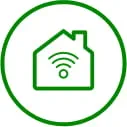You might not know this, but education is in the midst of a major transformation. Long gone are the days of dull textbooks, dusty erasers and limited resources.
Today's classrooms are embracing the power and reach of technology, and at the forefront of this revolution is fiber optic internet. Fiber offers fast speeds, increased bandwidth and unmatched reliability, fundamentally changing the way students learn and educators teach. Let's delve into how fiber optic internet is forever altering the education system.
But first, fiber
Traditional cable internet, which is what most people are familiar with, uses copper wire to transmit data, which weakens over distance. This means the farther you are from the source (your internet service provider), the slower and weaker your internet connection will be. Copper wires are also susceptible to electromagnetic interference (EMI) from sources like power lines, radio waves and even other cables. This interference can corrupt data signals, leading to slowdowns, dropped connections and unreliable performance. Finally, copper wires have limited bandwidth, which means they struggle to handle the ever-increasing demands of high-definition streaming, online gaming and large file transfers.
Fiber optic internet, on the other hand, uses thin glass or plastic fibers to send pulses of light that travel much faster and weakens far less than copper cable. Fiber internet is also less susceptible to interference from weather or electrical signals, resulting in a more stable connection. Finally, fiber can handle a much larger amount of data compared to cable, making it ideal for future technological advancements. Think of it like this: Imagine sending a message on a narrow, dusty dirt road with lots of potholes (copper) versus a wide, high-speed highway (fiber). Fiber offers a smoother, faster and more reliable journey for your data.
Unlocking a world of resources
While it might be hard to believe, there once was a time when the only tools a teacher had at their disposal to educate their students were a textbook, a blackboard, and, maybe, an overhead projector. But thanks to fiber internet, teachers now have seamless access to a worldwide array of educational resources. Students can now explore virtual museums and historical sites in stunning detail, bringing the past vividly to life. They can immerse themselves in interactive simulations and conduct virtual experiments in science, biology and engineering. Being able to access online libraries filled with e-books, academic journals and multimedia content helps foster a culture of independent research. Resources such as these were once limited to privileged institutions, but with fiber internet, the world's knowledge becomes readily available to anyone wanting to learn.
Enhancing collaboration and communication
Real-time video conferencing allows students to connect with experts from around the world, bringing diverse perspectives and real-world experiences into the classroom, as well as promoting collaboration and communication. Interactive online platforms enable students to work together on projects, enhancing teamwork skills. Language learning becomes more immersive with video calls with native speakers and access to online language learning tools. These tools break down geographical barriers and create a more interconnected learning environment. Students can learn from and collaborate with peers from different cultures, helping to prepare them to succeed in a globalized world.
Personalized learning
Not all students learn in the same way or at the same speed. Fiber optic internet empowers educators to personalize learning experiences to cater to individual student needs and learning styles. Adaptive learning platforms can tailor the curriculum to each student’s strengths and weaknesses, ensuring they are neither bored nor overwhelmed. Online resources offer a variety of learning materials, from video lectures to interactive activities, allowing students to learn in the way that works best for them. Teachers can leverage online tools to create differentiated instruction plans, ensuring all students are challenged and supported. This shift towards personalized learning fosters a deeper level of engagement and helps to instill a lifelong love for learning.
Bridging the digital divide
Fiber optic internet ensures equitable access to quality education for all students. In underserved communities, fiber can connect schools to a wealth of online resources, leveling the playing field for students who may not have access to the latest technology at home. Fiber facilitates remote learning opportunities, allowing students in rural areas or those facing challenges attending school in person to continue their education. And it provides access to online tutoring and education programs, offering additional support for students who need it most. By closing the digital divide, fiber internet ensures that every student has the chance to succeed, regardless of geography or their background.
Conclusion
Fiber optic internet is not just about faster download speeds; it's about changing the very essence of learning. Fiber unlocks a literal world of resources, fosters collaboration, personalizes learning and helps bridge the digital divide. Fast fiber internet is paving the way for a brighter future for education, one that is more engaging, accessible and equitable for everyone.






